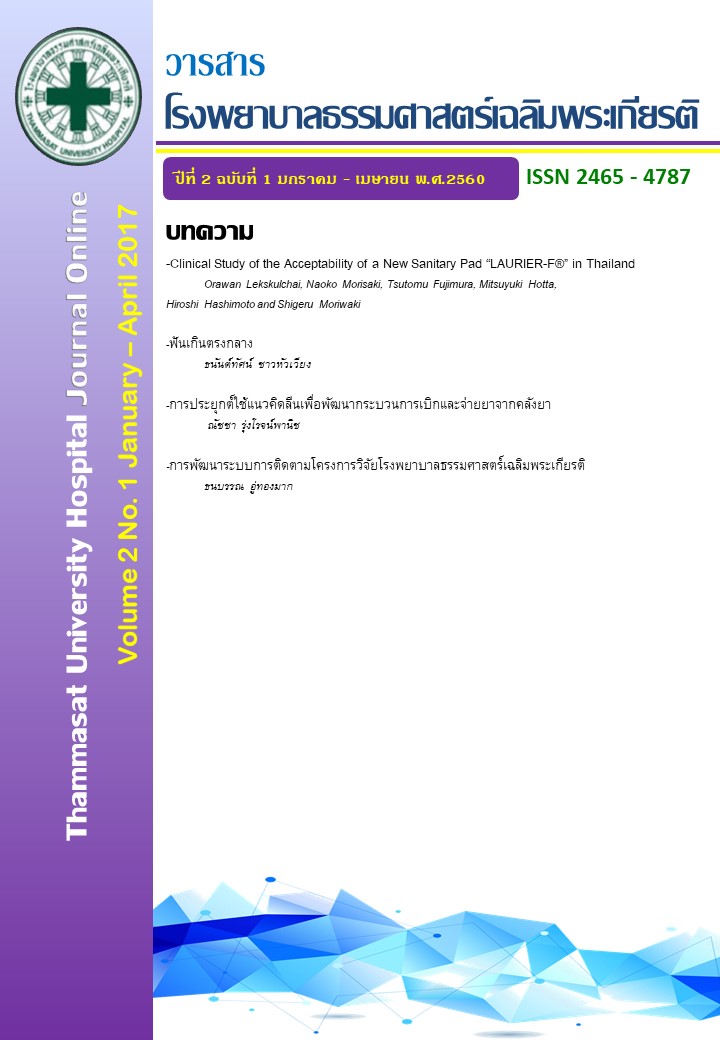Clinical Study of the Acceptability of a New Sanitary Pad “LAURIER-F®” in Thailand
Abstract
Background: The use of sanitary pads often causes contact dermatitis (sanitary pad dermatitis).Some possible causes of sanitary pad dermatitis are over-hydration by occlusion, irritation by menstrual blood, infestation of bacteria and friction with surface materials. Modern disposable sanitary pads were developed to reduce those causes. In this study, we examined the effects of a new sanitary pad product on subjects with skin eruptions in Thailand.
Methods: The subjects of this study were healthy adult women with symptoms of sanitary pad dermatitis assessed by a gynecologist. The test sanitary pad was “LAURIER-F®” (Kao Corporation, Tokyo, Japan, commercially available in Japan) and the control was each subject’s favorite sanitary pad. This was a crossover clinical usage study over the course of two menstrual periods. The diagnosis of eruptions and subjective symptoms was assessed by a gynecologist during two menstrual periods using each type of sanitary pad and between those menstrual periods (Control phase).
Results: Although we previously evaluated skin eruptions with sanitary pad usage after the end of the menstrual period, it is well known that sanitary pad dermatitis recovers rapidly after the end of the sanitary pad use. Due to the diagnosis of skin eruptions during the menstrual period, the preventive effects of “LAURIER-F®” on sanitary pad dermatitis were clearly detected by a doctor’s evaluation. The results suggest that sanitary pad users realize skin care effects of “LAURIER-F®” because their subjective symptoms also showed a similar tendency.
Conclusion: The tested “LAURIER-F®” sanitary pad did not cause a serious sanitary rash. Its surface is soft with good blood absorption. The gynecologist assessed collectively that the “LAURIER-F®” sanitary pad is highly effective to reduce sanitary pad dermatitis compared with conventionally used ones. It is considered that the characteristic features of the “LAURIER-F®” sanitary pad, such as softness, low-irritancy and high absorbency, are important factors to exert its efficacy
.
References
Eason EL and Feldman P. Contact dermatitis associated with the use of Always sanitary napkins. Can Med Assoc J 1996; 154:1173-1176.
Wakashin K. Sanitary napkin contact dermatitis of the vulva: location-dependent differences in skin surface conditions may play a role in negative patch test results. J Dermatol 2007; 34:834-837.
Rademaker M. Allergic contact dermatitis to a sanitary pad. Australas J Dermatol 2004; 45:234-235.
Farage M, Elsner P and Maibach H. Influence of usage practices, ethnicity and climate on the skin compatibility of sanitary pads. Acta Gynecol Obset 2007; 275:415-427.
Fujimura T, Sato N, Takagi Y, Ohuchi A, Kawasaki H, Kitahara T, Takema Y and Rizer RL. An investigator blinded cross-over study to characterize the cutaneous effects and suitability of modern sanitary pads for menstrual protection for women residing in the USA. Cutan Ocul Toxicol 2011; 30:205-211.
Hanke-Baier P, Johannigmann J, Levin RJ and Wagner G. Evaluation of vaginal and perineal area during the use of external sanitary protection throughout the menstrual cycle. Acta Obstet Gynecol Scand 1994; 73:486-491.
Farage MA, Katsarou A, Tsagroni E, Bowtell P, Meyer S, Deliveliotou A and Creatsas G. Cutaneous and sensory effects of two sanitary pads with distinct surface materials: a randomized prospective trial. Cutan Ocul Toxicol 2005; 24:227-241.
Runeman B, Rybo G, Larkö O and Faergemann J. The vulva skin microclimate: influence of panty liners on temperature, humidity and pH. Acta Derm Venereol 2003; 83:88-92.
Runeman B, Rybo G, Forsgren-Brusk U, Larkö O, Larsson P and Faergemann J. The vulvar skin microenvironment: influence of different panty liners on temperature, pH and microflora. Acta Derm Venereol 2004; 84:277-284.
Stadler M, Tischler H, Wambebe C, Osisanya T and Farage MA. An investigator-blind, single-center, controlled, parallel group study to confirm the suitability of sanitary pads for menstrual protection in an ethnic Nigerian population. Cutan Ocul Toxicol 2006; 25:273-279.
Xuemin W, Sato N, Chao Y, Na L, Fujimura T, Takagi Y, Nojiri H, Kitahara T and Takema Y. Cutaneous and sensory effects of two types of sanitary pads with different surfaces in the Shanghai, Chinese population. Cutan Ocul Toxicol 2011; 30:212-216.
Sato N, Toyoshima Y, Takagi Y, Ogawa A, Ohkouchi K, Kikuchi K, Kumasaka K, Saijo S, Hosokawa M, Watabe M and Tagami H. Clinical study on the preventive effects of skin care napkin “Laurier F®” on sanitary napkin dermatitis. Skin Res 2007; 6:300-308.
Yonei N, Satoh N, Takagi Y, Yamamoto Y and Furukawa F. The effect of sanitary napkin (Laurier F®) on the skin condition and the QOL of women with napkin dermatitis. Aesthetic Dermatology 2009; 19:60-67.
Margesson LJ, Contact dermatitis of the vulva. Dermatol Ther 2004; 17:20-27



